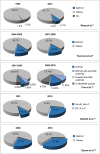Epidemiology of non-alcoholic fatty liver disease-related hepatocellular carcinoma and its implications
- PMID: 30483595
- PMCID: PMC6206984
- DOI: 10.1002/jgh3.12070
Epidemiology of non-alcoholic fatty liver disease-related hepatocellular carcinoma and its implications
Abstract
Hepatocellular carcinoma (HCC) is the fifth most common cancer and the second leading cause of cancer-related mortality worldwide. Non-alcoholic fatty liver disease (NAFLD) encompasses a spectrum of liver pathology that is characterized by the excessive accumulation of fat in the liver attributable to overnutrition and is strongly associated with the metabolic syndrome. Non-alcoholic steatohepatitis is the more severe form of NAFLD that is defined histologically by the presence of lobular inflammation and hepatocyte ballooning. Non-alcoholic steatohepatitis patients have a greater tendency to develop advanced liver fibrosis, cirrhosis, and HCC. This review focuses on the epidemiology of NAFLD-related HCC and its implications. NAFLD has been estimated to contribute to 10-12% of HCC cases in Western populations and 1-6% of HCC cases in Asian populations. NAFLD-related HCC is expected to increase in Asian populations, in line with the increased prevalence of NALFD similar to that of Western populations in recent years. The increasing burden of NAFLD-related HCC over time has been demonstrated in studies from both Western and Asian populations. Certain factors such as ethnicity, obesity, and diabetes mellitus appear to have an incremental effect on the risk of developing HCC among NAFLD patients. The difficulty in identifying NAFLD patients with cirrhosis and the possibility of HCC developing in noncirrhotic NAFLD patients are challenges that need to be addressed. Further understanding of these gaps may contribute to better surveillance strategies for the early detection of HCC in NAFLD patients to reduce the mortality and improve the survival of these patients.
Keywords: epidemiology; hepatocellular carcinomanon‐alcoholic fatty liver diseasenon‐alcoholic fatty liver disease‐related hepatocellular carcinoma.
Figures
Similar articles
-
Trends in hepatocellular carcinoma due to non-alcoholic fatty liver disease.Expert Rev Gastroenterol Hepatol. 2019 Feb;13(2):179-187. doi: 10.1080/17474124.2019.1549989. Epub 2018 Dec 29. Expert Rev Gastroenterol Hepatol. 2019. PMID: 30791782 Review.
-
Nonalcoholic fatty liver disease, metabolic risk factors, and hepatocellular carcinoma: an open question.World J Gastroenterol. 2015 Apr 14;21(14):4103-10. doi: 10.3748/wjg.v21.i14.4103. World J Gastroenterol. 2015. PMID: 25892859 Free PMC article. Review.
-
Non-alcoholic fatty liver disease and hepatocellular carcinoma: Clinical challenges of an intriguing link.World J Gastroenterol. 2022 Jan 21;28(3):310-331. doi: 10.3748/wjg.v28.i3.310. World J Gastroenterol. 2022. PMID: 35110952 Free PMC article. Review.
-
Non-alcoholic fatty liver disease associated with hepatocellular carcinoma: An increasing concern.Indian J Med Res. 2019 Jan;149(1):9-17. doi: 10.4103/ijmr.IJMR_1456_17. Indian J Med Res. 2019. PMID: 31115369 Free PMC article. Review.
-
Clinical epidemiology and disease burden of nonalcoholic fatty liver disease.World J Gastroenterol. 2017 Dec 21;23(47):8263-8276. doi: 10.3748/wjg.v23.i47.8263. World J Gastroenterol. 2017. PMID: 29307986 Free PMC article. Review.
Cited by
-
Quantitative multiparametric magnetic resonance imaging can aid non-alcoholic steatohepatitis diagnosis in a Japanese cohort.World J Gastroenterol. 2021 Feb 21;27(7):609-623. doi: 10.3748/wjg.v27.i7.609. World J Gastroenterol. 2021. PMID: 33642832 Free PMC article.
-
Gut metabolites and inflammation factors in non-alcoholic fatty liver disease: A systematic review and meta-analysis.Sci Rep. 2020 Jun 1;10(1):8848. doi: 10.1038/s41598-020-65051-8. Sci Rep. 2020. PMID: 32483129 Free PMC article.
-
Non-alcoholic steatohepatitis and risk of hepatocellular carcinoma.Chin Med J (Engl). 2021 Dec 1;134(24):2911-2921. doi: 10.1097/CM9.0000000000001888. Chin Med J (Engl). 2021. PMID: 34855640 Free PMC article. Review.
-
Red and Processed Meat Intake in Relation to Non-Alcoholic Fatty Liver Disease Risk: Results from a Case-Control Study.Clin Nutr Res. 2022 Jan 26;11(1):42-49. doi: 10.7762/cnr.2022.11.1.42. eCollection 2022 Jan. Clin Nutr Res. 2022. PMID: 35223680 Free PMC article.
-
Homeobox Genes and Hepatocellular Carcinoma.Cancers (Basel). 2019 May 3;11(5):621. doi: 10.3390/cancers11050621. Cancers (Basel). 2019. PMID: 31058850 Free PMC article. Review.
References
-
- Torre LA, Bray F, Siegel RL, Ferlay J, Lortet‐Tieulent J, Jemal A. Global cancer statistics, 2012. CA Cancer J. Clin. 2015; 65: 87–108. - PubMed
-
- Wong VW, Chan WK, Chitturi S et al The Asia‐Pacific Working Party on Nonalcoholic Fatty Liver Disease Guidelines 2017 Part 1: definition, risk factors and assessment. J. Gastroenterol. Hepatol. 2018; 33: 70–85. - PubMed
-
- Younossi ZM, Koenig AB, Abdelatif D, Fazel Y, Henry L, Wymer M. Global epidemiology of nonalcoholic fatty liver disease‐meta‐analytic assessment of prevalence, incidence, and outcomes. Hepatology. 2016; 64: 73–84. - PubMed
-
- Adams LA, Lymp JF, St Sauver J et al The natural history of nonalcoholic fatty liver disease: a population‐based cohort study. Gastroenterology. 2005; 129: 113–21. - PubMed
-
- Jansen PL. Non‐alcoholic steatohepatitis. Eur. J. Gastroenterol. Hepatol. 2004; 16: 1079–85. - PubMed
Publication types
LinkOut - more resources
Full Text Sources


